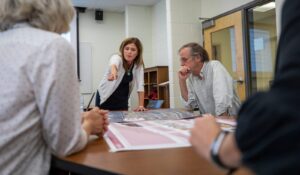“This is Home,” the phrase referencing Virginia Tech’s sense of place and community, is boasted by Hokies worldwide. But what distinguishes Virginia Tech’s 150-year-old Blacksburg campus? And more importantly, how will future construction emulate and preserve the iconic sense of place that Hokies across generations revere?
That’s exactly the role of the Division of Campus Planning, Infrastructure, and Facilities’ Office of University Planning: defining and curating the physical campus to ensure Virginia Tech’s legacy as “home.”
Placemaking focuses on people and their needs, creating an appreciation of a place or a feeling of home and belonging. “A college campus is a workplace, a home, a dining room, and more. We have the unique opportunity and responsibility to create moments where our students and employees can spend a lot of time comfortably socializing and recharging, and where our alumni can reconnect with one another,” said Stefanie Locklear, interior designer.
The multi-award-winning Office of University Planning is part of a high-performance cross-functional team that facilitates strategic enterprise-wide long-range physical planning, advancement of Virginia Tech’s capital outlay program, space management, land use, and campus aesthetics.
The team protects and maintains Virginia Tech’s sense of place by cohesively implementing the university’s campus master plan, Beyond Boundaries 2047: The Campus Plan, governed by the Virginia Tech design and construction standards and campus design principles.
“We provide guidance to site and building projects to verify alignment with aesthetics, material, accessibility, safety, to promote that sense of ‘being home’ while at Virginia Tech,” said Sandra Graham, director of campus design.
Graham, a Virginia Tech alumna, is one of three new members to join the team over the last six months. Rosalba Ledezma serves as the director of capital design and Jeffrey Dumars is the director of campus planning.
 Together, the Office of University Planning works collaboratively with other university units, the Town of Blacksburg, Montgomery County, the Virginia Department of Transportation, Virginia Department of Environmental Quality, and other entities to ensure responsible Blacksburg campus growth.
Together, the Office of University Planning works collaboratively with other university units, the Town of Blacksburg, Montgomery County, the Virginia Department of Transportation, Virginia Department of Environmental Quality, and other entities to ensure responsible Blacksburg campus growth.
“Planning for future development of the university is a coordinated effort with many valued stakeholders. Over the last 150 years, and especially in the last 50 of them, Virginia Tech has experienced significant growth. The Office of University Planning strives to meet the needs of a growing 21st century comprehensive research institution while paying homage to our land-grant heritage by preserving the bucolic character of our campus setting in Blacksburg and simultaneously creating create a bold new urban identity for the Virginia Tech experience in the greater Washington, D.C., metro area,” said Liza Morris, assistant vice president for planning and university architect.
“The goal is to create an experience that is unmistakably Virginia Tech, whether rural or urban.”

The current Blacksburg campus master plan uses smart growth principles that weave together density of development, mobility solutions, and thoughtful transportation planning to foster resilient and sustainable growth. The office analyzes new construction projects’ impacts on transportation and offers recommendations for improvements in efficiency and safety.
“Transportation planning explores all modes of transportation and how they impact campus. We have such a beautiful campus and we want to allow everyone to get around with minimal impact. We want to keep the campus pedestrian-friendly with the goal of access for all,” said Mike Dunn, assistant director of campus planning.
“With a campus this size, it’s exciting to see all the creative ways people get around.” Dunn, also an alumnus of Virginia Tech, studied mechanical and civil engineering. He also received his Virginia professional engineer license from the university in 2003.
Fostering accessible and inclusive spaces are also distinctly tied to the Virginia Tech design identity. The Infinite Loop and Green Links Design Guidelines – two award-winning features of the campus master plan for open space planning – developed routes and design characteristics to vastly improve accessibility, mobility, and the landscape of the Blacksburg campus pathways, which are challenged by topography and were largely developed prior to the Americans with Disabilities Act.
The Blacksburg campus is unique when compared with other public institutions with its significant portfolio of collegiate gothic architecture, iterating on this consistent theme and materials palette for the better part of a hundred years. However, the campus does reflect chronological and stylistic development of the institution, signifying periods of growth, changing pedagogies, alternate program emphasis, and deviations in aesthetic preferences.
Virginia Tech’s unique take on collegiate gothic architecture places emphasis on consistent massing and scale. Compositions often include tower elements, portals, and punched window openings, as well as moments of ornamentation in the form of heraldry. The materials palette consists largely of Hokie Stone – the locally quarried dolomitic limestone – with precast concrete, metals such as zinc, and materials for doors, windows, and occasionally wood utilized in portals. The palette is intentionally refined to create a muted backdrop to emphasize the dramatic landscape setting of campus.

